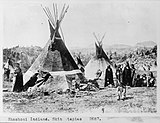The Bear River Massacre, also called the Battle of Bear River and the Massacre at Boa Ogoi, took place on January 29, 1863, between the United States Army and the Shoshone Indians at the confluence of the Bear River and Beaver Creek (now Battle Creek) near Preston in present day Franklin County, Idaho. The detachment of the U.S. Army was led by Col. Patrick Edward Connor as a part of the Bear River Expedition against Shoshone Chief Bear Hunter.
There were several incidents in the summer and fall of 1862 that lead to the eventual confrontation. While viewed as isolated incidents they seem insignificant, when grouped together a picture of broad struggles over almost the entire United States west of the Mississippi River can be seen during this time period when the attention of the nation was focused on the battles going on in the eastern states. Modern historians have often overlooked these incidents because they occurred near the ill-defined boundary of two different territorial jurisdictions (Washington Territory and Utah Territory), where the incidents are geographically close but the administrative centers dealing with them are over 1000 miles apart. Indeed, the vicinity of Franklin and the general location of the conflict was assumed to be in the Utah Territory, with residents of Franklin sending elected representatives to the Utah Territorial Legislature and participating in the politics of Cache County, Utah until 1872 when a surveying team pointed out that they were, in fact, in Idaho. (Full article...)
